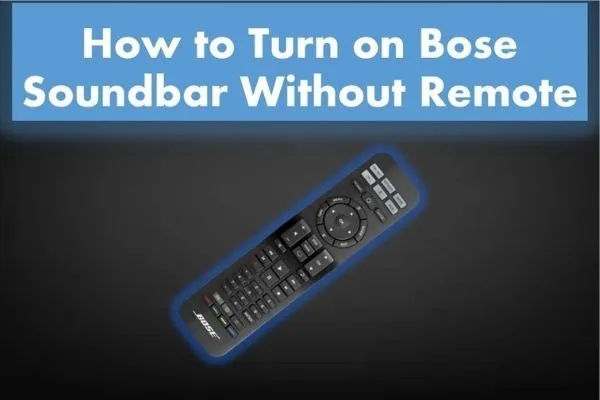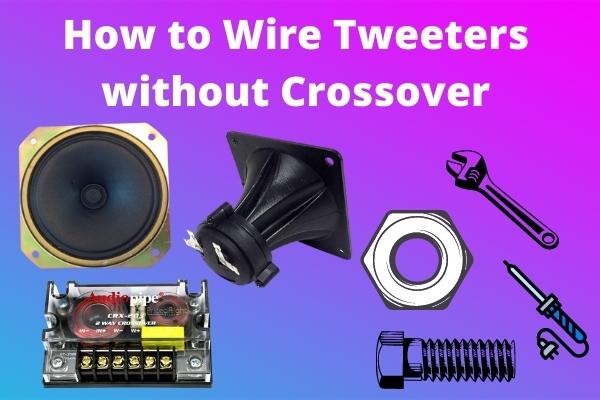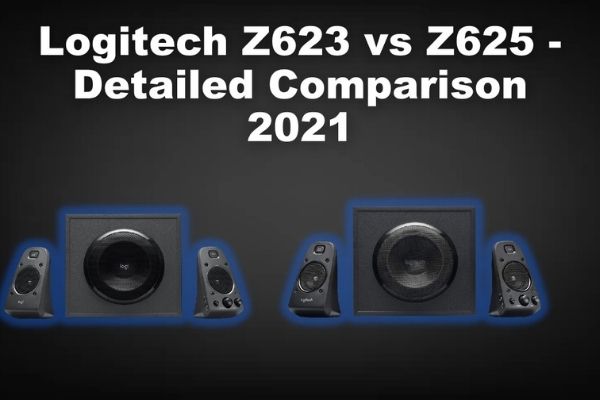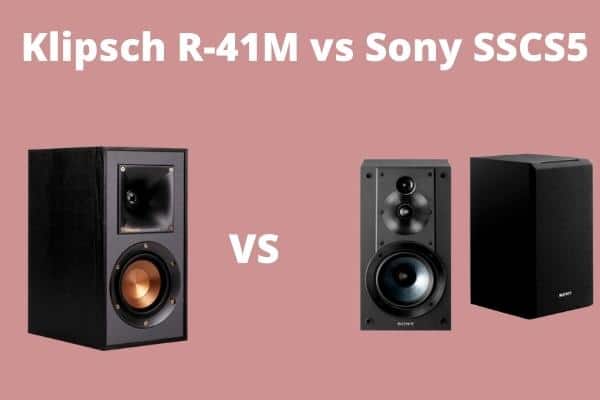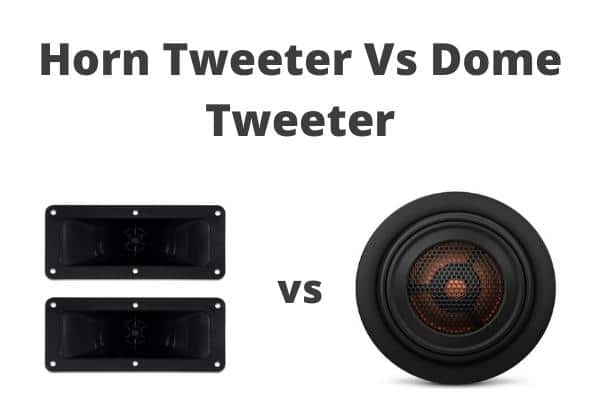
It is impossible to compromise on sound quality to enjoy music to the fullest when it comes to music. It often gets difficult to decide whether you should go for a horn tweeter or a dome tweeter regarding frequencies. Each has specific features, Horn Tweeter vs Dome Tweeter makes you choose one of them from both.
If you want to feel the music to the fullest, you need a sound system to play all of the frequencies in a soundtrack. It is the best way to enjoy the optimum listening experience. However, it can be not very clear at times which one should you prefer, between horn tweeters or dome.
To help it understand better, here, we will discuss horn vs dome tweeter in detail.
What exactly is a Tweeter?
The definition of a tweeter might be a little confusing if you don’t know much about audio systems. But no worries, we’ll make sure to explain it in the simplest way possible. Tweeters are miniature loudspeakers that create high-frequency sounds.
Most sound systems are divided into multiple portions. If you want clear, precise sounds, you need the proper equipment for the right frequency. Mostly, we find tweeters in vehicles and home stereo systems.
Tweeters can be classified into three parts, and those are:
1. Speakers
Speakers are designed to play frequencies and make the frequencies travel back and forth. Larger speakers take longer to move massive drivers, so they are unsuitable for high frequencies. Tweeters are made up of considerably smaller drivers that aren’t as difficult to move as larger speakers.
2. Drivers
Tweeters have a working mechanism nearly identical to that of a standard speaker. They use drivers to move a flexible cone (made of multiple materials). Nonetheless, the size difference between tweeters and other drivers is one of the most significant.
Unlike woofers and subwoofers, which have enormous speakers to handle the bass, tweeters have much smaller speakers to handle the highest-pitched sounds.
3. Frequencies
Stereo systems split audio impulses into different frequencies, primarily high, medium, and bass. The system’s components send each frequency to its proper driver. In most situations, all of the equipment is housed under one roof.
And each driver is intended to handle the frequency for which it was designed. The total sound quality produced by the equipment simultaneously creates a memorable experience.
Horn Tweeters

A horn tweeter is usually found in a three-way speaker, a big speaker unit. A bass, midrange, and tweeter are included in these speakers. The tweeter is usually located at the top of the speaker box and is protected by a horn-shaped covering. Here we have the features of horn tweeters listed below.
1. Three-Way Speakers
The three-way speakers can play all frequencies within one speaker box. This form of tweeter design makes the speakers more powerful. Horn tweeters have been around for a lot longer than dome tweeters.
2. Compact Size
Tweeters with horns are more efficient because horn tweeters create more sound than dome tweeters. A horn tweeter’s design keeps the cone area large while compacting the overall size.
3. Power Levels
Horn tweeters are said to be less sensitive to power levels. Unless the space proportions are correct, there may be some concerns with sound quality when you have high sensitivity and no filters that separate small bands of frequencies. Otherwise, for the optimum experience, listeners must remain in one zone about where loudspeakers/sound sources are located.
4. Design
Horn tweeters have a unique design that helps them disseminate sound more evenly. They provide for improved sound output directivity. As a result, we can use these as high guide frequencies to a specific listening position.
Dome Tweeters

Dome tweeters have been used in audio for quite a long time. They’re among the most common tweeters found in automotive audio and home audio systems. We have listed the dome tweeters’ features below to understand them better.
1. Design
Titanium, silk, aluminum, plastic, and other materials construct dome tweeters. A metallic wire is wrapped around the rim of an actual dome in this design. Depending on the basic material, the performance of these speakers can vary.
They provide a pleasant sound, although not as loudly as metallic tweeters. Metal dome tweeters and soft dome tweeters are two different types of dome tweeters.
Metal Dome Tweeters
Tweeters composed of metal alloys such as aluminum, titanium, or beryllium are metal dome tweeters. They have better breakup modes than soft tweeters, resulting in sharper peaks and valleys and more detailed sound. However, even the best metal dome tweeters produce different results depending on the user. Some may sound harsh and annoying at high volumes, while others sound clear.
Soft Dome Tweeters
Soft dome tweeters are similar to other types of tweeters that they function in the same way. When an electrical signal flows through them, they have a voice coil that moves freely in an electromagnetic field. The character of the sound production in dome tweeters is affected differently by various materials.
Soft dome tweeters are considered more well-damped than metal tweeters, resulting in more consistent frequency response. They’re less rigid, and their wide dispersion and good accuracy make them a popular choice.
2. Speaker
The more current you feed a speaker, the greater volume it will produce. A speaker needs the correct amount of energy to maximize its capabilities, but not too much because else everything around it will crumble.
Ringing is often caused due to increased rigidity because it provides a significantly higher resonance frequency. It is one of the drawbacks of rigidity, and it’s one of the reasons dome-shaped tweeters aren’t ideal.
3. Stiffness
The resonance rating of a speaker is crucial. Resonance ratings ensure that you do not exceed the speaker’s limits. It’s to ensure that you don’t do anything you shouldn’t. To be clear, the resonance rating of a speaker is vital, so we’ll describe it as simply as possible.
4. Low Mass
A dome tweeter requires a low mass to move quickly and produce high frequencies. In addition, there is a lot of inflexibility. High stiffness is good for less distortion in general. It occurs because waves will not be able to affect the geometry of a cone when a magnet is pushed up through it.
5. Damping
Because of their sound dispersion, dome-shaped tweeters are excellent for acoustics. However, it is because of this feature that it requires more power. A dome-shaped tweeter will blow out and require dampening if it receives too much power to compensate. The dome’s materials determine the degree of damping.
Horn Tweeter Vs Dome Tweeter

So far, we have discussed the difference between horn and dome tweeters; now, let’s look at a comparison of which one should be your pick. So, without further ado, we have the comparison between horn tweeter and dome discussed below.
| Horn Tweeters | Dome Tweeters | |
| Frequencies | The fundamental function of a horn tweeter is to create high frequencies that are clear, sharp, and detailed. It accomplishes this by producing sound utilizing piston motion, which allows it to cover most of the audio spectrum but not all of it. | The fundamental function of a dome tweeter is to generate a broad, linear frequency response across the whole audible range. It accomplishes this by producing sound utilizing piston motion, which allows it to cover most of the audio spectrum but not all of it. |
| Performance | Horn tweeters are frequently utilized in home theatre and stereo systems where tweeter size isn’t a major consideration. However, the aesthetics of tweeter performance are better than acoustic performance. | Dome tweeters are frequently more fragile and expensive than other tweeter types. As a result, they’re frequently seen in high-end speakers when tweeter size isn’t as critical as acoustic performance. |
| Design | Horn tweeters are often extremely fragile, as they can quickly break if not handled properly. | Dome tweeters come in two varieties, soft-dome and metal-dome. Soft dome tweeters are a bit fragile, but metal domes are not. |
| Durability | Horn tweeters lack diaphragms and ultra-light voice coils seen in other tweeters; these are more durable than the dome tweeter. | When it comes to durability, metal domes are more durable than soft domes. |
| Sound | These tweeters have a wide sweet spot, you don’t have to worry about placing it close to your ears, but if you’re mixing for a large group, they won’t likely hear the same sound as you do due to the distance between them and the tweeter. | These tweeters can easily handle both high and low frequencies. It also has a crisper sound, making it perfect for mixing. |
Conclusion
We cannot say which tweeter is better than the other as both are different support applications. Dome tweeters are a good option if you want modern tweeters with well-balanced highs, greater dispersion, and a low price tag. On the other hand, horn tweeters are a good option if you want more efficient tweeters that can produce more directed highs.

